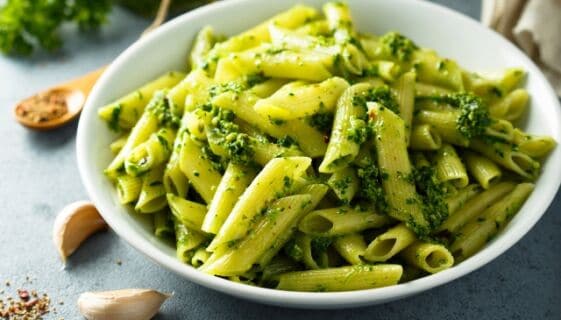August is all about tomatoes, and our summer ratatouille recipe is a tasty way to celebrate this sweet, ripe, juicy, fragrant fruit. Ratatouille is not only fun to say but also fun to make. Fresh, in-season tomatoes are critical to this anticancer, gut-supporting, and heart-healthy one-pot dish. The tomatoes are grated or pulsed in a food processor and then cooked with olive oil, onions, garlic, and herbs to create an irresistible cooking base for the other summer vegetables: eggplant, zucchini, summer squash, and bell peppers.
We recommend making a big batch since leftovers can be used to transform into various other meals. Serve on its own as a satisfying vegetarian main entrée or over grains or pasta (we love it over egg noodles), alongside fish or tofu, folded into an omelet, topped on toasted bread for a savory snack, or blended with yogurt or beans for a flavor-packed dip. Try alongside our herb-based salmon!
Ratatouille
Serves: 4 as entrée or 8 as a side
Ingredients
Sauce
- 6 medium or 4 large ripe red tomatoes (it is important to buy organic tomatoes for flavor and to avoid most pesticides.)
- 1 tablespoon olive oil
- 1 small-medium onion, diced
- 4 garlic cloves, minced
- ¼ cup fresh chopped basil
- ¼ teaspoon red pepper flakes
- ½ teaspoon dried oregano
- ½ teaspoon fresh or dried thyme
Vegetables
- High-heat oil (avocado or sunflower)
- 1 medium eggplant, diced into ½ inch cubes
- 1 large zucchini, diced into ¼ inch half moons
- 1 large yellow summer squash, diced into ¼ inch half moons
- 1 large bell pepper (any color), diced into ½ inch squares
- 1 pint cherry or grape tomatoes, sliced in half
- Salt and black pepper
Directions
- To prepare your tomatoes, remove the cores with a paring knife. Then, grate them on the large holes of a box grater into a bowl. This is easiest if you hold the tomato at a diagonal. Chop any remaining tomato skin. Or pulse the tomatoes in a food processor until they are broken into a frothy pulp. Set aside.
- Heat a large, rimmed skillet or Dutch oven over medium heat with 2 tablespoons of high-heat oil. Once hot, add the eggplant and season with salt and pepper. Cook for about 10-12 minutes, stirring occasionally for even browning and cooking. Once browned and softened, transfer to a plate.
- Return the pan to heat and add 1 tablespoon of high-heat oil. Add zucchini, squash, and bell peppers to the pan. Season with salt and pepper and cook until vegetables are tender-crisp and beginning to brown. Cook for about 5-8 minutes, stirring occasionally for even cooking.
- Add in cherry tomatoes and cook for another 5 minutes until tomatoes have blistered, stirring occasionally. Transfer veggies to the same plate as the eggplant.
- Lower heat to medium-low. Add olive oil and onions. Cook onions for 5 minutes until translucent, not browned, stirring often. Add in garlic and cook until fragrant, about 1-2 minutes. Add in grated tomatoes, basil, oregano, and red pepper flakes. Stir together to get all the bits off the bottom of the pan. Cook for another 3 minutes.
- Add back in all the vegetables, bring to a gentle boil, then reduce the heat to low and simmer for 10-15 minutes, until vegetables are tender and the sauce has thickened. Taste and adjust seasoning.
- Serve with fresh herbs and a drizzle of olive oil.
Leftovers can be stored in an airtight container in the refrigerator for up to 6 days or frozen for up to 2 months.
Nutrient highlights
Tomatoes: A great source of lycopene that helps reduce the risk of cancer and heart disease and protect skin integrity. Cooking tomatoes in healthy fat increases the amount of available lycopene the body will absorb.
Zucchini & Summer Squash: Nutrient-dense vegetable packed with fiber and water that aids digestive health. The insoluble fiber helps us stay regular, and the soluble fiber is a “prebiotic” food for good bacteria to promote a healthy gut. This vegetable’s high amount of zeaxanthin (a powerful antioxidant) also plays a role in preventing oxidative stress to reduce the risk of developing cancer.
Eggplant: The deep purple vegetable contains properties that can help increase circulation and lower LDL cholesterol (bad cholesterol) and triglyceride levels. Eggplants also contain solasodine rhamnosyl glycosides (SRGs) that have assisted with reducing tumor size by causing death to cancer cells and reducing the recurrence of certain types of cancer.
Bell Peppers: All colors of bell peppers are from the same plant. A bell pepper starts out green and, as it ripens, it will become yellow, then orange, red, or purple, depending on the variety. As the bell pepper ripens, there is also an increase in the nutrient concentration, with orange and red having the highest. Bell peppers have high amounts of antioxidants called carotenoids that help protect cells from oxidative damage.
Herbs: Herbs are rich in nutrients such as Vitamins A, C, and K and are packed full of antioxidants that help reduce oxidative stress in the body. Such antioxidants are lutein, beta carotene, and zeaxanthin, which are known to reduce the risk of cancer and can prevent age-related macular degeneration and support liver health.
Garlic and Onions: Considered a prebiotic, it feeds the “good” bacteria in our gut and promotes a healthy digestive system. Research supports that the compounds such as allicin in garlic and onions have antioxidant, anti-inflammatory, antimicrobial, and cardioprotective properties.



 Ananda Kaplan
Ananda Kaplan


